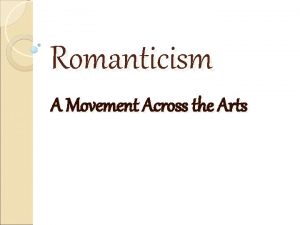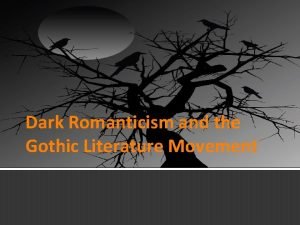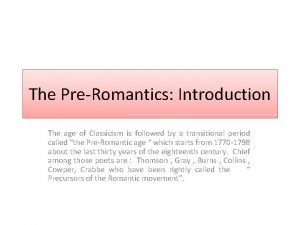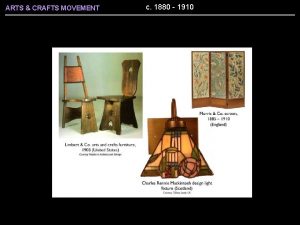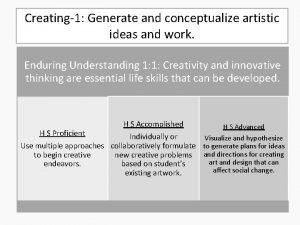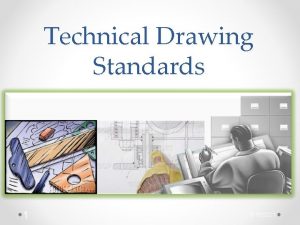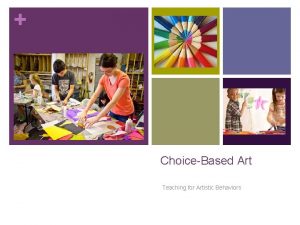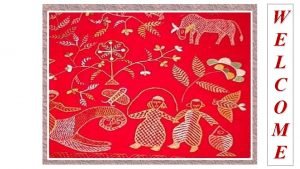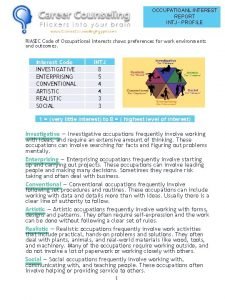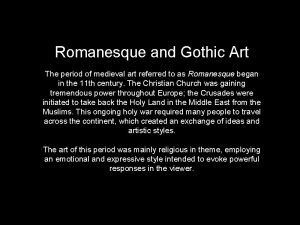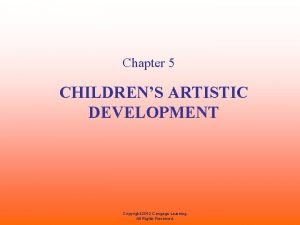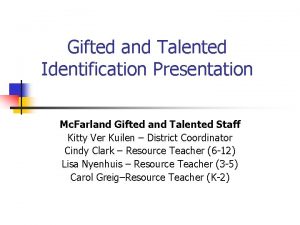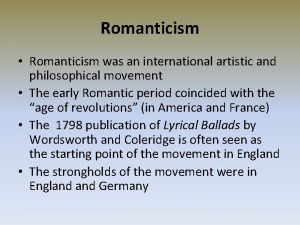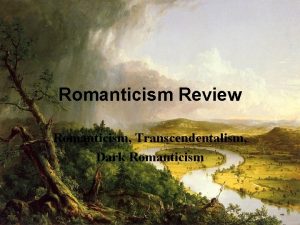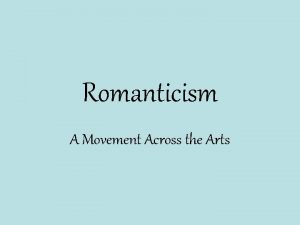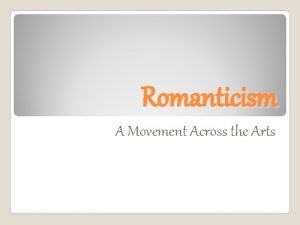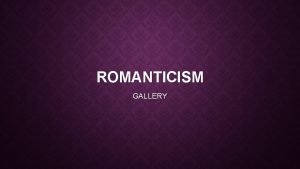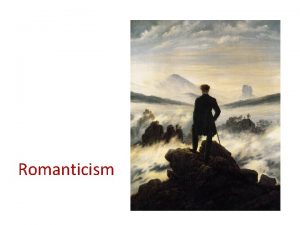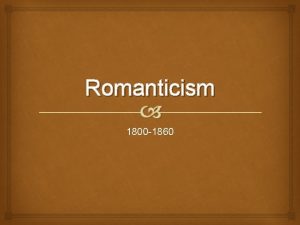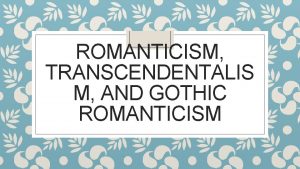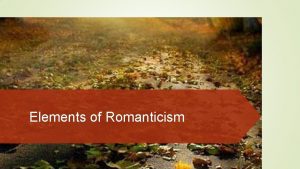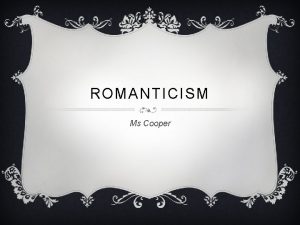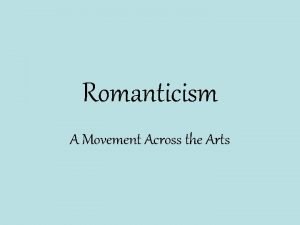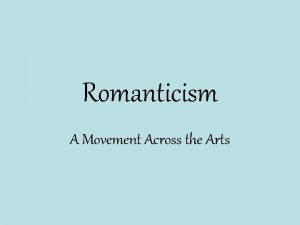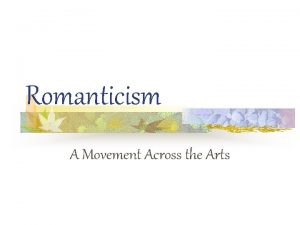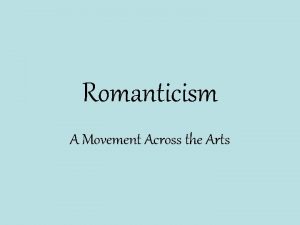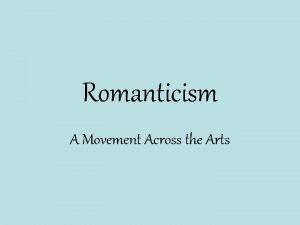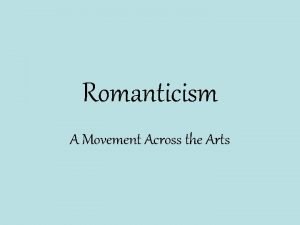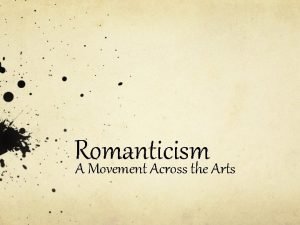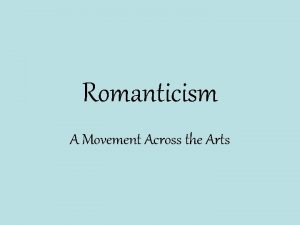Romanticism A Movement Across the Arts Artistic Philosophical



















- Slides: 19

Romanticism A Movement Across the Arts

Artistic & Philosophical Movement – Late 18 th Century – Mid 19 th Century – European, to lesser extent American – Response to Industrialization – Related to the rise of Nationalism Enlightenment Romanticism • Reason • Universal Truths • Natural Order • Academies • Patronage • Neoclassical • Society • Imagination/Emotion • Human Uniqueness • Nature is Wild • Artistic Individualism • Independence • Medieval Romances • Solitude

Early 19 th Century Period of Social Upheaval • French Revolution 1789 • Series of revolutions in Europe 1820 -1848 • Industrial Revolution – England – France – Germany • Urbanization

Turn and Talk #1 With a neighbor, make sure you have the correct answers on your handout. Then, discuss what it must have been like to be a lower class person during this period in England. Jot some of your ideas down on your handout.

Definition v. Romanticism refers to a movement in art, literature, and music during the 19 th century. v. Romanticism is characterized by the five “I”s v. Imagination v. Intuition v. Idealism v. Inspiration v. Individuality

Imagination v. Imagination was emphasized over “reason. ” v. This was a backlash against the rationalism characterized by the Neoclassical period or “Age of Reason. ” v. Imagination was considered necessary for creating all art. v. British writer Samuel Taylor Coleridge called it “intellectual intuition. ”

Intuition v. Romantics placed value on “intuition, ” or feeling and instincts, over reason. v. Emotions were important in Romantic art… fuel for creativity. v. British Romantic William Wordsworth described poetry as “the spontaneous overflow of powerful feelings. ”

Idealism v. Idealism is the concept that we can make the world a better place. v. Idealism refers to any theory that emphasizes the spirit, the mind, or language over matter – thought has a crucial role in making the world the way it is. v. Immanuel Kant, a German philosopher, held that the mind forces the world we perceive to take the shape of space-and-time.

Inspiration v. The Romantic artist, musician, or writer, is an “inspired creator” rather than a “technical master. ” v. What this means is “going with the moment” or being spontaneous, rather than “getting it precise. ”

Individuality v. Romantics celebrated the individual (including the common person). v. During this time period, Women’s Rights and Abolitionism were taking root as major movements. v. Walt Whitman, a later Romantic writer, would write a poem entitled “Song of Myself”: it begins, “I celebrate myself…”

Turn and Talk #2 With a neighbor, discuss some of the differences in the ideology of the Restoration writers and the Romantic writers. How could these differences affect the writing we will be studying? Jot some of your ideas down on your handout.

Origins v. Romanticism began to take root as a movement following the French Revolution. v. The publication of Lyrical Ballads by William Wordsworth and Samuel Taylor Coleridge in 1792 is considered the beginning of literary Romanticism. v. The new focus will be common folks and common language!

The Arts v. Romanticism was a movement across all the arts: visual art, music, and literature. v. All of the arts embraced themes prevalent in the romances of the Middle Ages: chivalry, courtly love etc. v. Literature and art from this time depicted these themes. Music (ballets and operas) illustrated these themes. v. Shakespeare came back into vogue.

Visual Arts v Neoclassical art was rigid, severe, and unemotional; it hearkened back to ancient Greece and Rome v Romantic art was emotional, deeplyfelt, individualistic, and exotic. It has been described as a reaction to Neoclassicism, or “anti-Classicism. ”

Visual Arts: Examples Neoclassical Art Romantic Art

Music v “Classical” v Romantic musicians included composers like Mozart and Haydn. v 1730 -1820 v Classical music emphasized internal order and balance. musicians included composers like Chopin, Lizst, and Tchaikovsky v 1800 -1910. v Romantic music emphasized expression of feelings.

Literature v In America, Romanticism most strongly impacted literature. v Writers explored supernatural and gothic themes. v Writers wrote about nature – Transcendentalists believed God was in nature, unlike “Age of Reason” writers like Franklin and Jefferson, who saw God as a “divine watchmaker, ” who created the universe and left it to run itself (aka Deism).

Turn and Talk #3 Are your fill-ins complete and correct? Discuss: Based on what you know about the French Revolution, why do you think is had such a profound effect on philosophers, writers, and artists? Jot some of your ideas down on your handout.

Pick & Choose With a partner, pick one questions from each color group. Record you answers in complete sentences. Define Romanticism in your own words. What are the most important facts in the Power. Point? Describe the philosophy of this period. How do you feel about rebellion? How do you feel about the idea of the importance of the individual? What are the subjects Romantic poets preferred to write about? What evidence did you see in the presentation that the arts were changing? Compare and contrast the Restoration and Romanticism. Why do you think Wordsworth wanted to switch from lofty language to more common language? Create a metaphor for rebellion. How would it sound if you composed a instrumental song to capture the Romantic Movement? Design a symbol representing Romantic poets.
 Philosophical and artistic movement
Philosophical and artistic movement Creative arts grade 7 term 2: drama
Creative arts grade 7 term 2: drama The romanticism (1795 — 1835) what is romanticism
The romanticism (1795 — 1835) what is romanticism Dark romanticism literature
Dark romanticism literature Pre romanticism and romanticism
Pre romanticism and romanticism Arts and crafts movement 1880 to 1910
Arts and crafts movement 1880 to 1910 Movement and non movement area
Movement and non movement area Locomotor and axial movements examples
Locomotor and axial movements examples 3 influences of his first sorrow of rizal
3 influences of his first sorrow of rizal Generate and conceptualize artistic ideas and work
Generate and conceptualize artistic ideas and work Artistic social enterprising
Artistic social enterprising The physical outline of a display
The physical outline of a display Technical terms in drawing
Technical terms in drawing Artistic behaviors
Artistic behaviors Naksha means artistic
Naksha means artistic Introduction of technical drawing
Introduction of technical drawing Intj artistic careers
Intj artistic careers Artistic elements of notre dame la grande france
Artistic elements of notre dame la grande france Theories of child art development
Theories of child art development Artistic
Artistic
